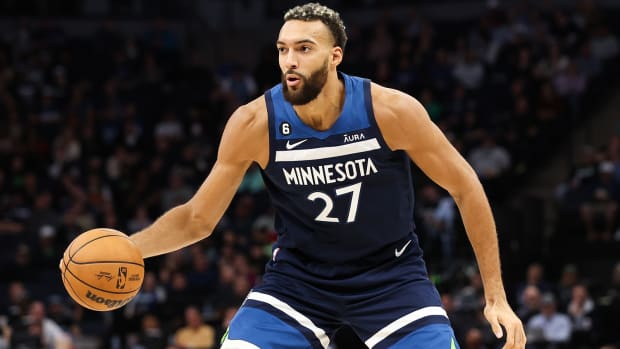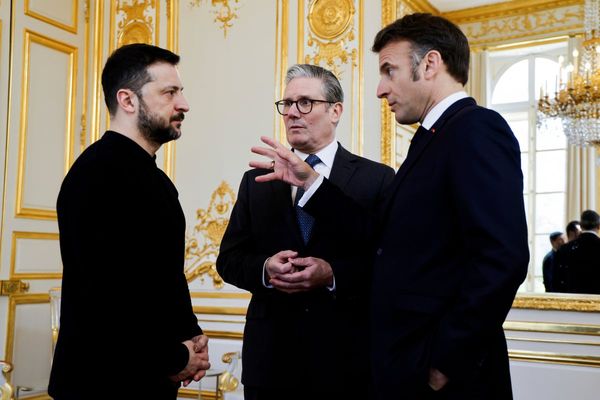Rudy Gobert returns to Utah on Friday for the first time since the Jazz traded him in the summer. And rather surprisingly, the Jazz will be ahead of the Timberwolves in the standings when the two teams meet, this despite Utah also trading Donovan Mitchell in the offseason, a series of moves that indicated a rebuilding year. The Gobert and Mitchell trades were only two of a few big trades that went down over the summer. In the spirit of Gobert’s return, let’s look at how some of those trades have fared a little more than a quarter into the season, starting with Rudy himself.
Rudy Gobert, Timberwolves
As previously mentioned, Minnesota is not only behind Utah in the standings, the T-Wolves (as of Dec. 8) are 11th in the West, currently outside the play-in tournament. Minnesota is behind teams such as the Kings (who haven’t made the playoffs in forever), the Grizzlies (whose best players haven’t played together) and Mavericks (who lost their second-best player in the offseason).
Putting all the blame on Gobert would be unfair. At the same time, he hasn’t had the impact the team would want from a major acquisition considering all that the Wolves gave up for him—five players, four first-round picks and a pick swap. Minnesota’s defense is only 15th in the league, which is atypical for a Gobert-led unit. Usually his individual brilliance is enough to put a team in the top 10 defensively, and that hasn’t been the case so far.

Matt Krohn/USA TODAY Sports
Meanwhile, Gobert’s fit with the Wolves’ stars hasn’t been clean. The trio of Gobert, Anthony Edwards and Karl-Anthony Towns has a middling 0.8 net rating in 374 minutes together. They’ve been stout defensively but clunky offensively. Edwards has already said he plays better in smaller lineups. Meanwhile, Austin Rivers has said the team needs to be more dominant in the paint if Towns and Gobert are playing together. Team president Tim Connelly said this week he expected “growing pains” for his new big-man duo.
Simply put, the Gobert trade isn’t working at the moment. Ultimately, If the goal was to supercharge a team that didn’t make it out of the first round last year, the Wolves are currently closer to not making it back to the playoffs than making it deeper into the postseason.
Donovan Mitchell, Cavaliers
On the other hand, the second jettisoned Jazzman has been thriving. Mitchell has been outstanding for the Cavaliers. Cleveland is third in the East as well as third in net rating in the whole league 25 games into the Mitchell era. Donovan has been a fringe MVP candidate, averaging a career-best 29 points per game on career-high percentages from the field, three-point range and the free throw line. (Mitchell is remarkably close to a 50/40/90 season, shooting 49.6%, 42.4% and 89.0% from the field, three and line, respectively.)
The offensive explosion has been essential, with numerous Cavs in and out of the lineup. Cleveland has only one five-man group that’s played 100 minutes together this year. Interestingly, the Cavs haven’t always set the world on fire with Mitchell, Darius Garland, Evan Mobley and Jarrett Allen sharing the floor together. Those four cornerstones share only a 1.2 net rating in 216 minutes. But what the Cavs have this year is better Garland insurance. Cleveland has a positive net rating when Mitchell is on the floor without Garland, as well as when Garland is on the floor without Mitchell. A year after running the offense exclusively through Garland, the Cavs now have much better lineup flexibility and don’t have to worry about bleeding points if one of their star guards sits. With trade flexibility to find the proper fifth player to put next to their four young building blocks, Cleveland is in a good spot.
Dejounte Murray, Hawks
Hmm. This is a weird one. Murray himself has been pretty good so far this season. His scoring has gone up and his efficiency has been more or less in line with where it was last season. His assists and rebounds are down, though that’s to be expected playing on a better team. And his fit with Trae Young has been solid enough, as the duo has a 4.7 net rating in 563 minutes together.
Yet the Hawks leave a bit to be desired. Overall Atlanta has a minus-1.0 net rating, 18th-best in the league. Unlike Cleveland, they have been getting clobbered whenever one of Young or Murray sits. And Young is having the worst shooting season of his career from both the field and three, and his shot profile has seen an increase in inefficient twos. It’s hard to pin all of that on Murray, and his arrival also has nothing to do with a key injury to Bogdan Bogdanović and the curious case of John Collins’s disappearing jump shot.
It’s strange, because of all the star groupings between Atlanta, Minnesota and Cleveland, the Young-Murray pair has put up the best numbers. But the Hawks feel closer to the Wolves than the Cavs in terms of overall success. Atlanta was bumped in the first round last season, and it certainly doesn’t look to be a shoo-in to go further this year. But the Hawks are reportedly being active on the trade market, so perhaps bringing in some more fresh faces could help unlock the potential of their talented backcourt.
Smaller moves
Jerami Grant has been one of the home run moves of the offseason. He is averaging a career-best 23 points a night for the Trail Blazers, including shooting a truly confounding 46.1% from three. He helped keep Portland afloat during injuries to Damian Lillard, as he’s played only 11 games with Dame. While Portland has cooled off a bit after a hot start, the Blazers should be very intriguing at full strength, with another offseason addition in Gary Payton II seemingly getting ready to make his season debut soon.
Malcolm Brogdon has been fantastic for the Celtics, fitting in smoothly with their three-point-heavy offensive attack. Patrick Beverley has been unspectacular and possibly expendable for the Lakers. P.J. Tucker can still defend any wing player in the league, though he’s given the Sixers nearly nothing on offense after being a little frisky on that end of the floor for the Heat last year.







